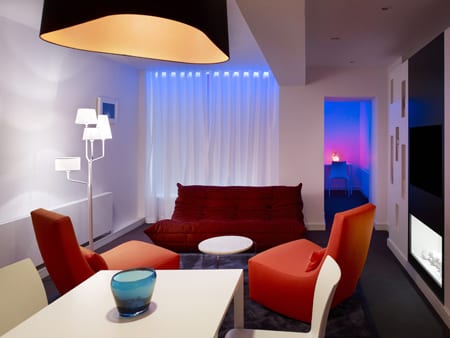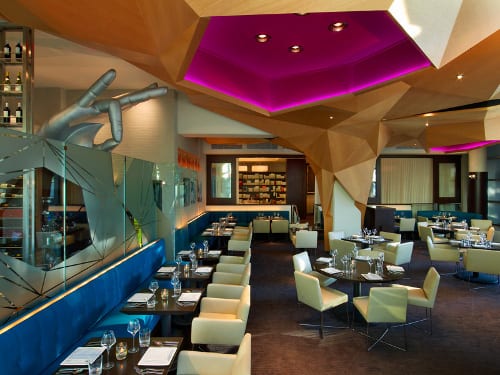
Photography courtesy of Starwood Hotels & Resorts
In 2001, Barry Sternlicht appeared on Charlie Rose’s PBS interview show to discuss his rise in the hotel world, and particularly the then-recent success of the W brand. "We wanted to make hotels fun again," said Sternlicht, citing his attempts to target the younger traveler, his competition with Ian Schrager, and the company’s desire to "create an urban oasis" that would make the traveler an enthusiastic return guest.
"A lot of people—some of the bigger hotel chains—think it’s a fad, a fading fad," he said to Rose, Sternlicht’s wide smile suggesting that he couldn’t disagree more. But it’s unlikely that even he could have foreseen the blossoming of the brand today, some five years after he left Starwood to pursue other hospitality endeavors:

• By 2012, the brand has plans in place to triple its global footprint: there are nearly 30 Ws today, with 50 expected by the end of 2010, 60 by 2012.
• After branching out significantly in the U.S. over the past decade, efforts to create an international presence continue apace, from Istanbul to Hong Kong, Doha to Santiago. Not to mention Hoboken, New Jersey.
• W Resorts, Starwood’s efforts to bring the urban oasis to "the wild," follows its 2006 debut with projects in Vieques, Koh Samui, and Bali.
• W’s residential/hotel mixed-use properties are heading for a handful of U.S. cities, including Hollywood, Dallas, and South Beach.
• Aloft, a new brand spun from W, and "bringing urban cool to unexpected places," has recently opened 10 properties in the U.S., with its first opening in Asia soon.
Fading fad? Hardly.
Through a heady combination of brains, chutzpah, imagination, and zeitgeist-tapping (and maybe a little bit of luck), Sternlicht had created a hotel concept that has managed in large measure to stay ahead of the trends while at the same time spawning a handful of competitors.

The W concept had a younger, hipper guest in mind than the classic hotel was wont to attract. Lobbies, once largely passage routes from front desk to guestroom, became party spots, luring city dwellers and travelers alike to their throbbing, attractive spaces. Fresh terminology—gyms became "sweat," the concierge became "whatever/whenever"—raised the hip quotient. And each hotel became its own retail store as W-branded products brought the hotel into the guest’s home experience.
"W has always served as Starwood’s innovation lab," says Simon Turner, president, global development, Starwood Hotels & Resorts Worldwide. "It spawned a myriad of concepts that have been adopted by other Starwood brands and the industry at large, from signature scents, designer minibar amenities, and branded CDs."

But from the very first, it was design that was front and center. Seizing on the public’s growing sense of style and visual cool, Sternlicht hired David Rockwell to fashion its inaugural entry into the field, W New York in Midtown, followed by W Union Square on 17th Street. (The W New York’s guestrooms and suites just got an overhaul by BBG-BBGM.) Rockwell, who is currently updating the downtown property, as well as putting the finishing touches on W Retreat & Spa-Vieques Island, recalls the early days of the brand: "I feel we were in the right place at the right time," he says, "and it was an amazing place to be. This was luxury wedded with hip, luxury that was comfortable and not intimidating."
Rockwell was and is impressed with the way the brand "gives designers a lot of permission; they always want their designers to bring fresh ideas. Like us, they like looking forward." Did he have any idea that those early hotels would spawn dozens more? "No idea at all," he says. "If I had, I would have negotiated a different proposal."

Over the years, W followed the Rockwell hire with a veritable who’s who of designers and architects: Jean Nouvel, Yabu Pushelberg, Studio Gaia, Clodagh, Charles Gwathmey, Tony Chi, Thom Filicia, ICRAVE, Carlos Castroparedes. And that mission has never wavered.
According to Turner, "W’s distinct design plays a critical role in bringing the brand’s unique positioning to life. Design is one of the reasons consumers want to stay at W, and it is a critical part of what keeps them coming back. Strong guest loyalty enables us to drive market-leading occupancy and rate."
W’s most recent executive hire is Eva Ziegler, global brand leader for W Hotels Worldwide. The Vienna-born Ziegler comes to W from the Starwood brand Le Meridien. She brings a passionate zeal to her new job, and is particularly enthusiastic at the brand’s projected international footprint. "In hotels," she says, "distribution across the world makes the brand strong."

W is nothing if not brand-conscious. In addition to Ziegler, W and other Starwood holdings are overseen by Phil McAveety, executive vice president and executive brand officer; and Mike Tiedy, senior vice president brand design and innovation. Says McAveety, "W began as a New York City phenomenon, but over the years it has needed to adapt to different markets. The functional lobby, creating a space for entertaining and being seen, has been copied a lot. Now we need to adapt it to different markets, driven mainly by a distinctive design direction."
"We want to use a myriad of designers," says Tiedy, "to help establish the storyline of each property. Every one has to be unique. No cookie cutters allowed."
Looking forward, Ziegler hopes to continue W’s partnerships with the fashion world, an initiative launched when W created a VIP Backstage Lounge for New York Fashion Week. "W’s ‘passion points’ are music and entertainment and fashion and design," she says. "We have developed entertainment and music alliances in London and Hollywood, and I want to bring fashion into products, marketing, and services. I want to find a fashion consultant to link our hotels with events and to develop a fashion point-of-view for our properties."

While W’s ambitious plans might seem at odds with an economy that is, to put it mildly, less than robust, Ziegler points out that the projects with scheduled openings were initiated some five years ago. "It’s not just all of a sudden we decided to go global," she says. "There is so much investment in these properties that it makes no sense to stop. And we have proof of past success.
Adds Turner: "We succeed by working with the right partners on the right properties in the right places. W’s critical mass, global footprint, and growth momentum put the brand at a distinct competitive advantage and positions it for success now, during the recovery and beyond."
"W’s target audience will always be the aspirational market," adds Ziegler. "Those who are the trend seekers and the trend setters. They want the latest, the coolest, the hottest, the newest."
Whether that remains true by 2012 is something the entire hospitality industry will be watching with interest. And if history is prologue, the W brand is likely to make this unfolding story well worth our attention.
——
W’s Winning Ways
We asked a number of W designers to offer their thoughts on working with the brand
"When W came to ICRAVE in 2006, they awarded us the Atlanta-Midtown project specifically because we had never designed a hotel before. They recognized our success in reinvention and our ability to take existing brands to the next level. It was the perfect client/designer match. Over the years W has become an iconic brand in the hotel industry They recognize the importance of cutting-edge design and the positive effect that design has on the overall guest experience. We have since gone on to collaborate with W on two VIP Lounges for Fashion Week and the destination bar, Chandelier Room at the W Hoboken." —Siobhan Barry, partner, ICRAVE
"The vision for the W brand has completely changed the hospitality trends and scene worldwide by giving the hotels a new meaning of design. They have created new standards for all companies to learn and model themselves after." —Ilan Waisbrod, president, Studio Gaia, W Seoul, W Mexico City
"Designing the W Scottsdale was a design experience like no other. Being able to create unique spaces, using the latest in design and fabric selections was exciting and challenging. My goal was to combine exotic textures and colors, all within an environmentally friendly atmosphere—which Starwood thrives on with its unique W brand."—Carlos Castroparedes, Castroparedes International Inc.
"I attended the birthday party for the first W on Lexington Avenue and instantly got the zeitgeist of what they had created. I made a wish right then to design a W, and it came true a few years ago when we were asked to design the largest W to date on the beach in Fort Lauderdale. We have pulled out all the stops to create a necklace of experiences that will enliven every aspect of the guest experience. Congratulations, W, on your 10th birthday!"—Clodagh, Clodagh Design
"We had always wanted to do a hotel, so we were thrilled when we were asked to freshen the W Westwood. It was just the kind of aspirational, lifestyle brand that matches what we do at our firm. W is all about design. That’s what I’m all about, that’s what our firm is all about. I told the W people that they should think of all of their hotels as children—there should be a common thread, but each should be defined by location, demographic, architecture, and so on. The experience of doing several Ws has been wonderful. We’ve grown together." —Thom Filicia, Thom Filicia Inc., W Atlanta-Buckhead, W Hollywood


